How to remove Errors Explained app from your browser
![]() Written by Tomas Meskauskas on (updated)
Written by Tomas Meskauskas on (updated)
What kind of application is Errors Explained?
The Errors Explained app is a helpful tool intended to enhance the browsing experience, assisting with decoding error codes. However, upon closer scrutiny, it becomes apparent that Errors Explained is, in fact, responsible for displaying bothersome and intrusive advertisements. These types of applications are classified within the adware category.
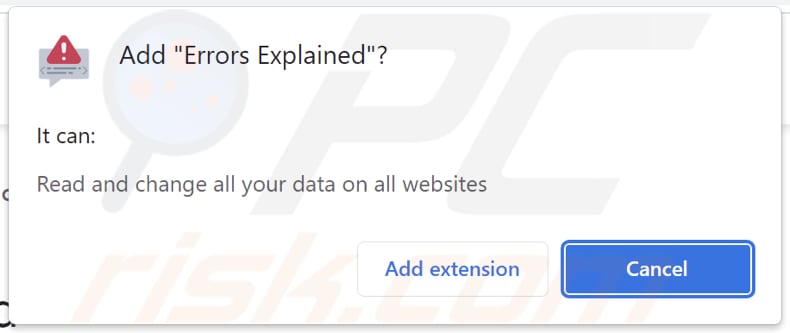
Errors Explained in detail
The Errors Explained app can display a variety of advertisements to users. These ads may include pop-up windows, banners, in-text ads, and full-page interstitials. Users can be led to various destinations when they click on these advertisements. Users may be redirected to websites that are affiliated with the advertisers.
In some cases, users might be directed to websites that host potentially harmful or misleading content, including scam sites or sites that attempt to distribute malware. These ads can lead to phishing pages designed to trick users into divulging sensitive information such as login credentials, credit card details, or personal data.
Also, users might be prompted to download software, browser extensions, or other files. These downloads can pose security risks, as they may contain unwanted or malicious components. To sum up, ads from Errors Explained can lead users to various online destinations, some of which may not be safe or attempt to deceive or compromise the user's security and privacy.
Another reason not to trust the Errors Explained app is that it can read and change data on all websites. This level of access could pose significant privacy and security concerns, as it means the app can gather information from all websites, including personal and sensitive data, without the user's consent.
Moreover, the ability to modify website data raises the risk of potential unauthorized alterations to web content, which could be exploited for malicious purposes, such as injecting ads or altering the appearance and functionality of websites.
| Name | Ads by Errors Explained |
| Threat Type | Adware |
| Symptoms | Your computer becomes slower than normal, you see unwanted pop-up ads, you are redirected to dubious websites. |
| Distribution methods | Deceptive pop-up ads, free software installers (bundling), torrent file downloads. |
| Damage | Internet browser tracking (potential privacy issues), display of unwanted ads, redirects to dubious websites, loss of private information. |
| Malware Removal (Windows) | To eliminate possible malware infections, scan your computer with legitimate antivirus software. Our security researchers recommend using Combo Cleaner. |
Conclusion
In conclusion, the Errors Explained app, initially marketed as a helpful tool for decoding error codes, raises considerable apprehension due to its intrusive advertising practices and extensive permissions that grant it access to and potential manipulation of data on all websites.
Users should exercise caution and consider the potential risks associated with this application, as it may compromise the browsing experience, privacy, and the integrity of web content.
More examples of apps classified as adware are Tab Clear, Search Center, and Your Errors Team.
How did adware install on my computer?
Users typically add browser extensions or install applications like Errors Explained to their computers through intentional actions or, sometimes, inadvertently. Users may encounter ads or pop-ups that prompt them to install these apps, often disguised as helpful tools.
Users may also download software from third-party websites or bundled with freeware, often without realizing that additional applications, like Errors Explained, are included. Social engineering tactics, such as misleading claims, enticing offers, or promises of enhanced functionality, can also persuade users to initiate the installation process.
How to avoid installation of unwanted applications?
Stick to reputable sources for software downloads, such as official websites or trusted app stores, and avoid third-party download sites or suspicious sources. When downloading software, carefully review the installation process, opting for custom or advanced settings to deselect any bundled applications that may come with the software.
Additionally, be cautious when clicking on ads, especially those promising free software or enticing offers. Ensure that your operating system and applications are regularly updated to patch security vulnerabilities, and use reliable antivirus or anti-malware software to provide an extra layer of protection.
Finally, remain vigilant about the permissions you grant to browser extensions and applications, and uninstall any software or browser add-ons that display unexpected or disruptive behavior. If your computer is already infected with rogue applications, we recommend running a scan with Combo Cleaner Antivirus for Windows to automatically eliminate them.
Website promoting the Errors Explained app:
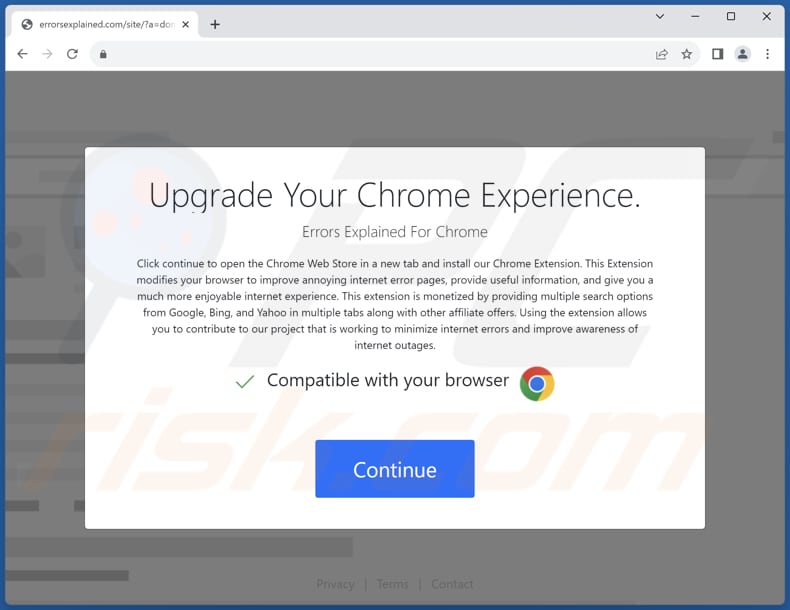
Instant automatic malware removal:
Manual threat removal might be a lengthy and complicated process that requires advanced IT skills. Combo Cleaner is a professional automatic malware removal tool that is recommended to get rid of malware. Download it by clicking the button below:
▼ DOWNLOAD Combo Cleaner
By downloading any software listed on this website you agree to our Privacy Policy and Terms of Use. To use full-featured product, you have to purchase a license for Combo Cleaner. 7 days free trial available. Combo Cleaner is owned and operated by Rcs Lt, the parent company of PCRisk.com read more.
Quick menu:
- What is Errors Explained?
- STEP 1. Uninstall adware applications using Control Panel.
- STEP 2. Remove rogue plug-ins from Google Chrome.
- STEP 3. Remove adware-type extensions from Mozilla Firefox.
- STEP 4. Remove malicious extensions from Safari.
- STEP 5. Remove rogue plug-ins from Microsoft Edge.
Adware removal:
Windows 11 users:

Right-click on the Start icon, select Apps and Features. In the opened window search for the application you want to uninstall, after locating it, click on the three vertical dots and select Uninstall.
Windows 10 users:

Right-click in the lower left corner of the screen, in the Quick Access Menu select Control Panel. In the opened window choose Programs and Features.
Windows 7 users:

Click Start (Windows Logo at the bottom left corner of your desktop), choose Control Panel. Locate Programs and click Uninstall a program.
macOS (OSX) users:

Click Finder, in the opened screen select Applications. Drag the app from the Applications folder to the Trash (located in your Dock), then right click the Trash icon and select Empty Trash.
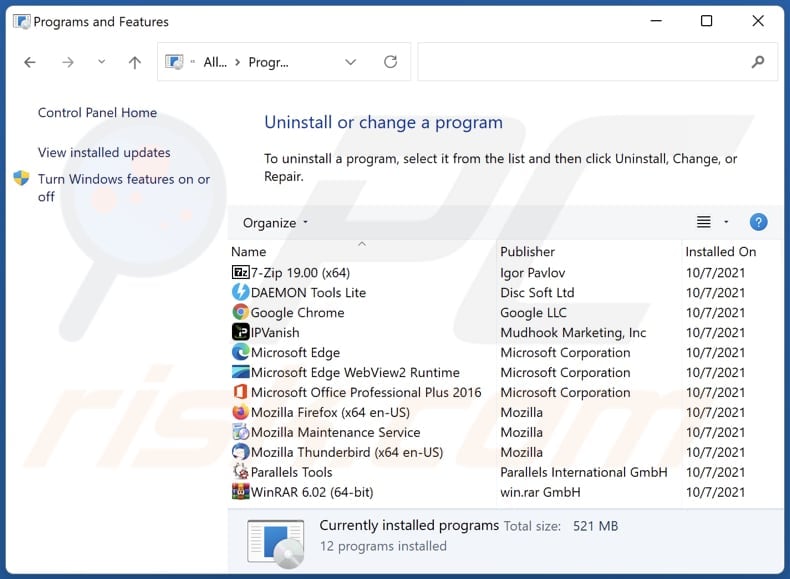
In the uninstall programs window, look for any unwanted applications, select these entries and click "Uninstall" or "Remove".
After uninstalling the unwanted application, scan your computer for any remaining unwanted components or possible malware infections. To scan your computer, use recommended malware removal software.
Remove adware from Internet browsers:
Video showing how to remove Errors Explained adware using Combo Cleaner:
 Remove malicious extensions from Google Chrome:
Remove malicious extensions from Google Chrome:
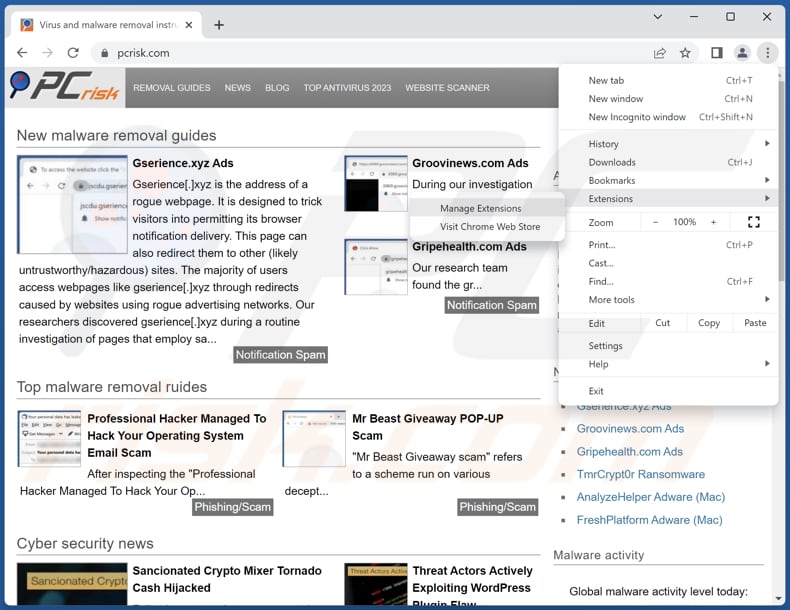
Click the Chrome menu icon ![]() (at the top right corner of Google Chrome), select "Extensions" and click "Manage Extensions". Locate "Errors Explained" or other suspicious extensions, select these entries and click "Remove".
(at the top right corner of Google Chrome), select "Extensions" and click "Manage Extensions". Locate "Errors Explained" or other suspicious extensions, select these entries and click "Remove".
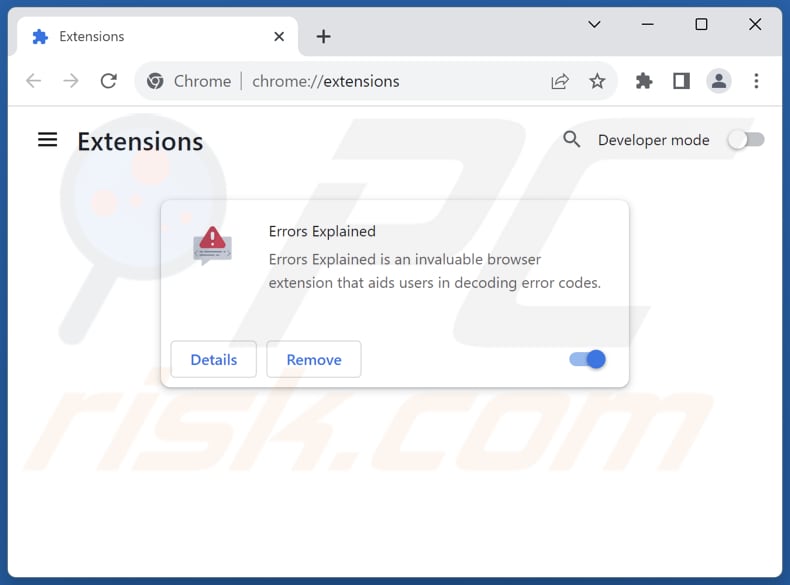
Optional method:
If you continue to have problems with removal of the ads by errors explained, reset your Google Chrome browser settings. Click the Chrome menu icon ![]() (at the top right corner of Google Chrome) and select Settings. Scroll down to the bottom of the screen. Click the Advanced… link.
(at the top right corner of Google Chrome) and select Settings. Scroll down to the bottom of the screen. Click the Advanced… link.

After scrolling to the bottom of the screen, click the Reset (Restore settings to their original defaults) button.

In the opened window, confirm that you wish to reset Google Chrome settings to default by clicking the Reset button.

 Remove malicious plug-ins from Mozilla Firefox:
Remove malicious plug-ins from Mozilla Firefox:
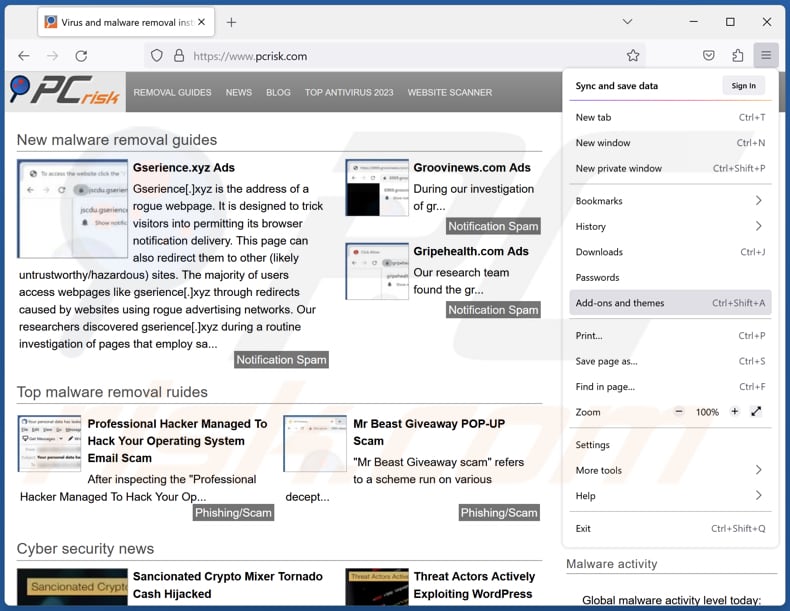
Click the Firefox menu ![]() (at the top right corner of the main window), select "Add-ons and themes". Click "Extensions", in the opened window locate all recently-installed suspicious extensions, click on the three dots and then click "Remove".
(at the top right corner of the main window), select "Add-ons and themes". Click "Extensions", in the opened window locate all recently-installed suspicious extensions, click on the three dots and then click "Remove".
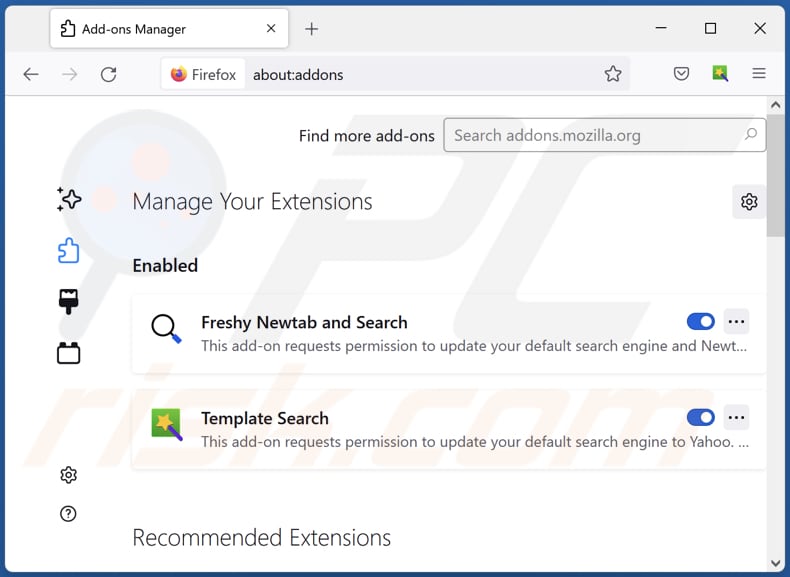
Optional method:
Computer users who have problems with ads by errors explained removal can reset their Mozilla Firefox settings.
Open Mozilla Firefox, at the top right corner of the main window, click the Firefox menu, ![]() in the opened menu, click Help.
in the opened menu, click Help.

Select Troubleshooting Information.

In the opened window, click the Refresh Firefox button.

In the opened window, confirm that you wish to reset Mozilla Firefox settings to default by clicking the Refresh Firefox button.

 Remove malicious extensions from Safari:
Remove malicious extensions from Safari:

Make sure your Safari browser is active, click Safari menu, and select Preferences....

In the opened window click Extensions, locate any recently installed suspicious extension, select it and click Uninstall.
Optional method:
Make sure your Safari browser is active and click on Safari menu. From the drop down menu select Clear History and Website Data...

In the opened window select all history and click the Clear History button.

 Remove malicious extensions from Microsoft Edge:
Remove malicious extensions from Microsoft Edge:

Click the Edge menu icon ![]() (at the upper-right corner of Microsoft Edge), select "Extensions". Locate all recently-installed suspicious browser add-ons and click "Remove" below their names.
(at the upper-right corner of Microsoft Edge), select "Extensions". Locate all recently-installed suspicious browser add-ons and click "Remove" below their names.

Optional method:
If you continue to have problems with removal of the ads by errors explained, reset your Microsoft Edge browser settings. Click the Edge menu icon ![]() (at the top right corner of Microsoft Edge) and select Settings.
(at the top right corner of Microsoft Edge) and select Settings.

In the opened settings menu select Reset settings.

Select Restore settings to their default values. In the opened window, confirm that you wish to reset Microsoft Edge settings to default by clicking the Reset button.

- If this did not help, follow these alternative instructions explaining how to reset the Microsoft Edge browser.
Summary:
 Commonly, adware or potentially unwanted applications infiltrate Internet browsers through free software downloads. Note that the safest source for downloading free software is via developers' websites only. To avoid installation of adware, be very attentive when downloading and installing free software. When installing previously-downloaded free programs, choose the custom or advanced installation options – this step will reveal any potentially unwanted applications listed for installation together with your chosen free program.
Commonly, adware or potentially unwanted applications infiltrate Internet browsers through free software downloads. Note that the safest source for downloading free software is via developers' websites only. To avoid installation of adware, be very attentive when downloading and installing free software. When installing previously-downloaded free programs, choose the custom or advanced installation options – this step will reveal any potentially unwanted applications listed for installation together with your chosen free program.
Post a comment:
If you have additional information on ads by errors explained or it's removal please share your knowledge in the comments section below.
Frequently Asked Questions (FAQ)
What harm can adware cause?
Adware can cause harm by bombarding users with disruptive ads, compromising their privacy through data tracking, slowing down system performance, and introducing security risks. It can also serve as a pathway for more harmful malware, leading to data breaches, identity theft, and financial fraud.
What does adware do?
Adware is a type of software that displays intrusive and often unwanted advertisements to users. Also, adware can monitor users' online behavior and function as a browser hijacker.
How do adware developers generate revenue?
Adware developers commonly generate revenue by promoting a range of products, websites, or services, with a significant portion of their earnings stemming from affiliate programs. Through these programs, developers receive commissions or payments for driving traffic to the promoted sites or for each successful sale or action resulting from their advertising efforts.
Will Combo Cleaner remove Errors Explained adware?
Combo Cleaner will conduct a comprehensive scan of your computer and effectively remove adware-type applications that have been installed. It is important to acknowledge that manual removal methods are not always foolproof, as remnants of files can linger within the system.


▼ Show Discussion